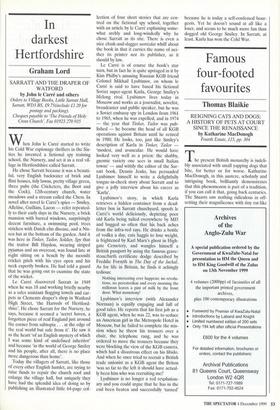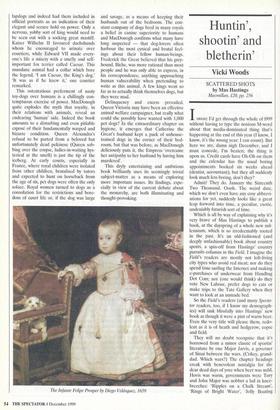Famous four-footed favourites
Thomas Blaikie
REIGNING CATS AND DOGS: A HISTORY OF PETS AT COURT SINCE THE RENAISSANCE by Katharine MacDonogh Fourth Estate, £15, pp. 304
The present British monarchy is indeli- bly associated with small yapping dogs that bite, for better or for worse. Katharine MacDonogh, in this austere, scholarly and intriguing book, brilliantly demonstrates that this phenomenon is part of a tradition, if you can call it that, going back centuries. The Stuarts saw nothing ridiculous in off- setting their magnificence with tiny rat-like
lapdogs and indeed had them included in official portraits as an indication of their elegant and secure hold on power. Only a nervous, yobby sort of king would need to be seen out with a socking great mastiff. Kaiser Wilhelm II favoured dachshunds whom he encouraged to urinate over courtiers, while Edward VII made every- one's life a misery with a smelly and self- important fox terrier called Caesar. This mundane animal had a collar which bore the legend, 'I am Caesar, the King's dog.' 'It was as if he knew it,' one courtier remarked.
This ostentatious preferment of nasty toy-dogs over humans is a chillingly con- temptuous exercise of power. MacDonogh quite explodes the myth that royalty, in their relations with animals, reveal an endearing 'human' side. Indeed the book amounts to a disturbing and even pitiable exposé of their fundamentally warped and bizarre condition. Queen Alexandra's refusal to be parted from a beloved but unfortunately dead pekinese (Queen sob- bing over the corpse, ladies-in-waiting hys- terical at the smell) is just the tip of the iceberg. At early courts, especially in France, where royal children were isolated from other children, brutalised by tutors and expected to hunt on horseback from the age of six, pet dogs were often the only solace. Royal women turned to dogs as a consolation for the restrictions and bore- dom of court life or, if the dog was large and savage, as a means of keeping their husbands out of the bedroom. The con- stant company of dogs bred in many royals a belief in canine • superiority to humans and MacDonogh confirms what many have long suspected — that dog-lovers often harbour the most cynical and brutal feel- ings about their fellow human-beings. Frederick the Great believed that his grey- hound, Biche, was more rational than most people and he was only able to express, in his correspondence, anything approaching human vulnerability when pretending to write as this animal. A few kings went so far as to actually think themselves dogs, but they were mad.
Delinquency and excess prevailed. Queen Victoria may have been an effective animal welfare campaigner, but really what could she possibly have wanted with 1,000 pet dogs? In the extraordinary chapter on hygiene, it emerges that Catherine the Great's husband kept a pack of unhouse- trained dogs in the corner of their bed- room, but that was before, as MacDonogh deliciously puts it, the Empress 'overcame her antipathy to her husband by having him murdered'.
This dryly entertaining and ambitious book brilliantly uses its seemingly trivial subject-matter as a means of exploring more important issues. Its findings, espe- cially in view of the current debate about the monarchy, are both illuminating and thought-provoking.
The Infante Felipe Prosper by Diego Veldsquez, 1659



















































































 Previous page
Previous page